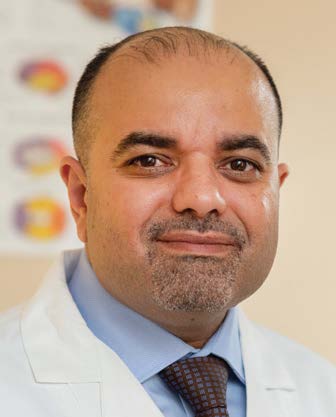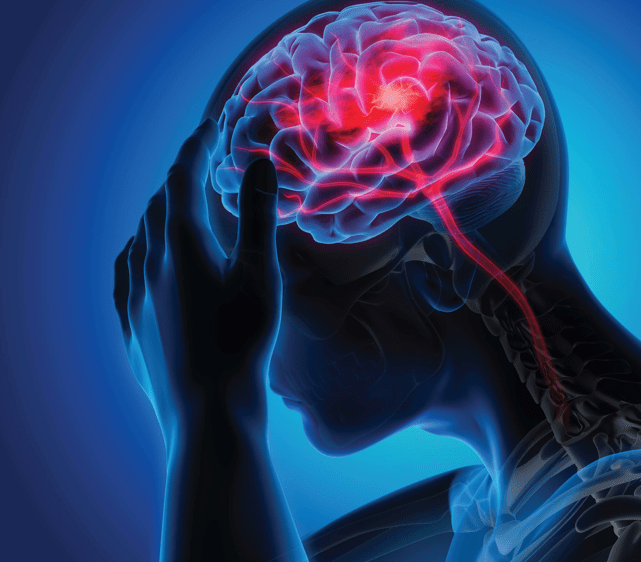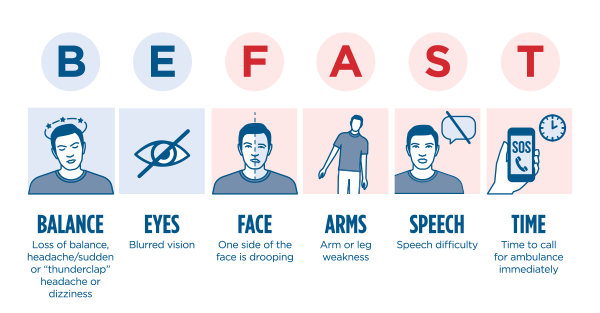Call 911 and ask to go to a primary stroke center.
If you or someone you’re with has signs of a stroke, call 911 immediately to save precious time. By the time the ambulance reaches the Emergency Department (ED), the EMTs will have started an IV and notified the ED that they are on the way with a possible stroke patient.

Patients who are fortunate enough to be near a medical center that has a certified Primary Stroke Center, as Clara Maass Medical Center (CMMC) does, will find highly trained specialists ready to take care of them. “My team will be waiting for the patient as they come through the door,” says Ayman Ibrahim, DO, Director of the Stroke Program at CMMC.
“They will be taken immediately for physician evaluation and will be sent for a CT scan, usually within 10 minutes. Is it a hemorrhagic stroke, caused by bleeding in the brain, or ischemic, caused by a blood clot? What time was the onset of symptoms? Once we know what we are dealing with, treatment begins immediately.”
A designation as a Primary Stroke Center by the New Jersey Department of Health ensures that patients receive a high standard of care, Dr. Ibrahim explains. This designation is significant because research shows that patients receiving care at a Primary Stroke Center are evaluated and treated faster and have a higher incidence of survival and recovery than those treated at centers without the certification.
“The designation makes sure that from the minute patients hit the ED, we have everything we need to treat them quickly—imaging, such as CT and MRI, laboratory facilities, a designated stroke team, pharmaceutical support and, if necessary, neurosurgical options,” says Dr. Ibrahim.
Advanced Treatment
One of the biggest advantages offered by a Primary Stroke Center is the administration of tissue plasminogen activator (tPA) for eligible ischemic strokes, says Dr. Ibrahim. A medication that dissolves clots, tPA is the only FDA-approved treatment for an ischemic stroke, the most common type, and its use dramatically improves stroke outcomes in appropriate patients, sometimes within minutes to hours of its administration. Studies show, however, that only about a quarter of eligible patients receive tPA, owing significantly to whether or not the facility is a Primary Stroke Center.
“Once we’ve established that tPA is appropriate for a patient, it will be administered by IV, usually within 30 minutes or less of arrival,” Dr. Ibrahim says. “A good outcome, of course, depends on many factors, but I always stress the importance to ‘act fast.’ With tPA, it must be given within four-and-a-half hours of symptom onset. The longer it’s been since the stroke began, the more damage can be done. For every hour of stroke symptoms, you lose a number of brain cells equal to what you’d lose in three-and-a-half years of normal aging.”
Continuity of Care
Being treated at CMMC’s Primary Stroke Center also ensures patients’ continuity of care, with both acute and following treatments performed by the same caregivers. Studies show that this continuing care is important in lowering the risk of stroke deaths.
The Stroke Center has its own Intensive Care Unit and dedicated inpatient stroke unit, where patients are cared for immediately following treatment. The CMMC Neurology Department provides treatment support from physical, occupational and speech therapy experts and, if necessary, therapy for swallowing—often a problem after stroke.
The length of stay in each area depends upon the extent of the stroke and the areas of the brain affected. Even after discharge to home, says Dr. Ibrahim, CMMC’s care continues.
“We have an onsite outpatient rehabilitation center, where patients continue to work on reaching their optimum outcome,” he explains.
Fast Action for Stroke Symptoms “If you or someone you know is experiencing stroke symptoms, one of the most important things to understand is that time is not on your side,” says John Fontanetta, MD, Chair of the Emergency Department at Clara Maass Medical Center. “Seconds count, and getting to the Emergency Department and the Primary Stroke Center as soon as you can is essential for a good outcome.” Recognizing a stroke is not always simple, but you can save precious minutes in getting treatment by learning what to look for. The acronym B.E.F.A.S.T. will help you identify stroke symptoms. BALANCE—sudden loss of coordination. EYES—sudden change in vision. FACE—drooping on one side. ARM—weakness or numbness. When both arms are raised, one arm drifts downward. SPEECH—difficulty, such as slurring or difficulty remembering words. TIME—to call 911.
Other symptoms include confusion, dizziness and headache. Dr. Fontanetta says to call 911 immediately upon noticing symptoms. “Do not drive yourself and don’t ask someone else to drive you,” he says. “Emergency crews have a lot of experience and will take steps to aid treatment. Call them. One of the first things they’ll ask is what time the symptoms began. So, take note of that time.” |
Learn more about stroke care at Clara Maass Medical Center, call 973-450-2000.

